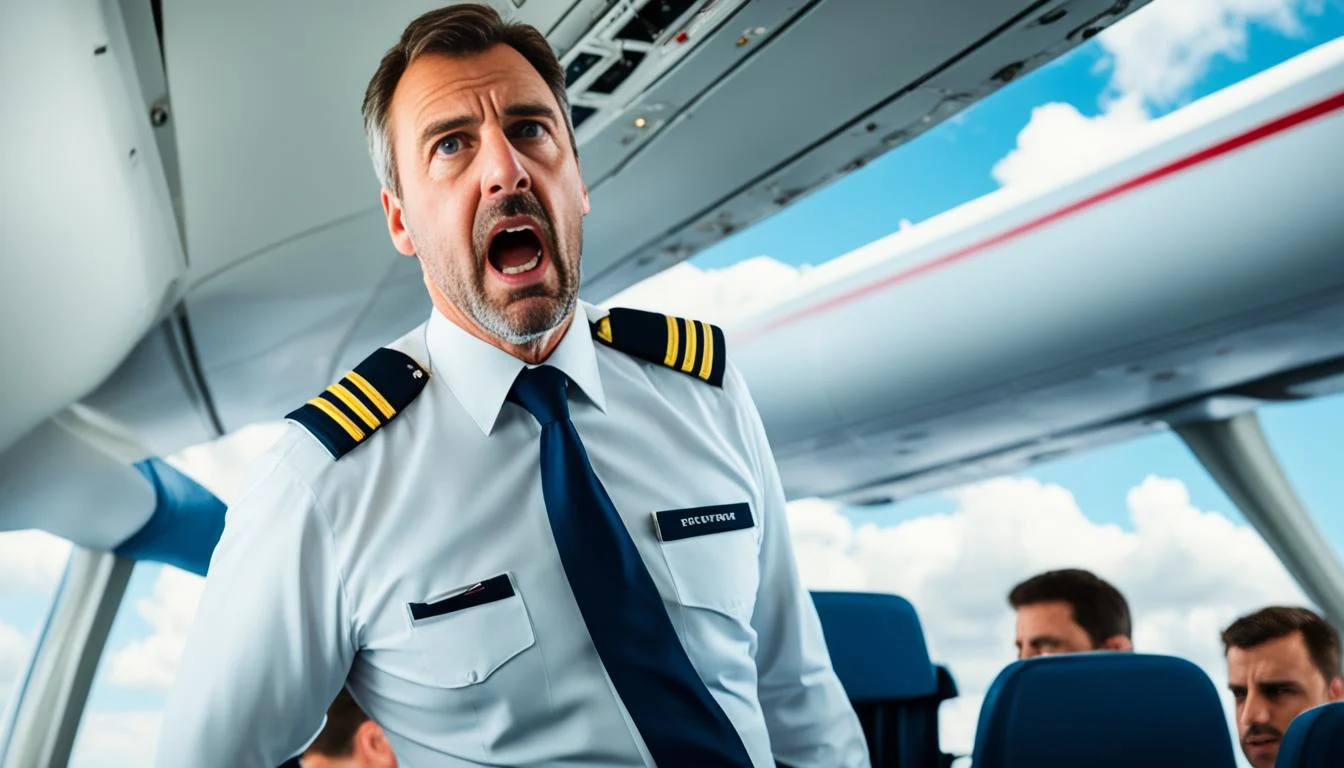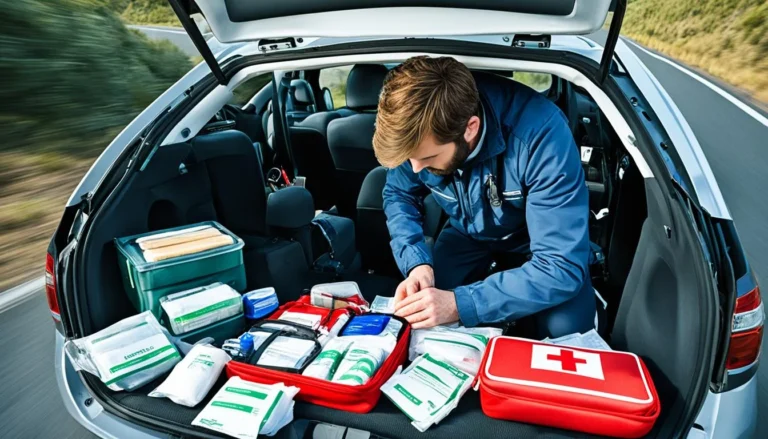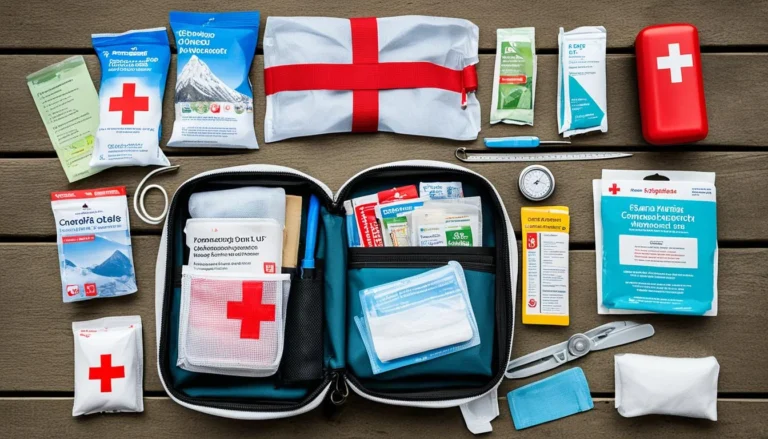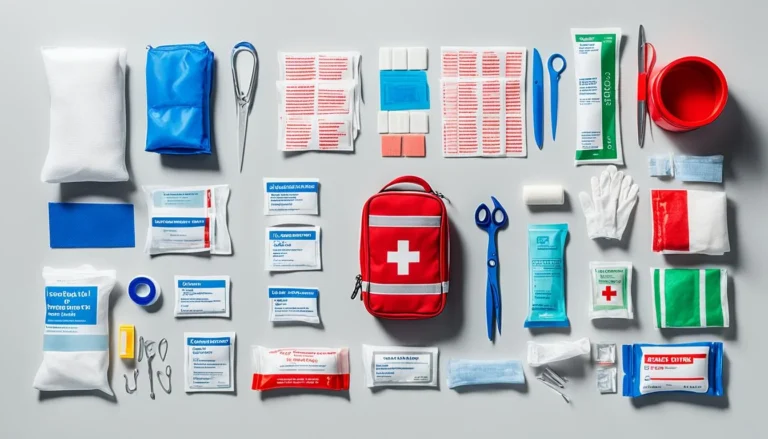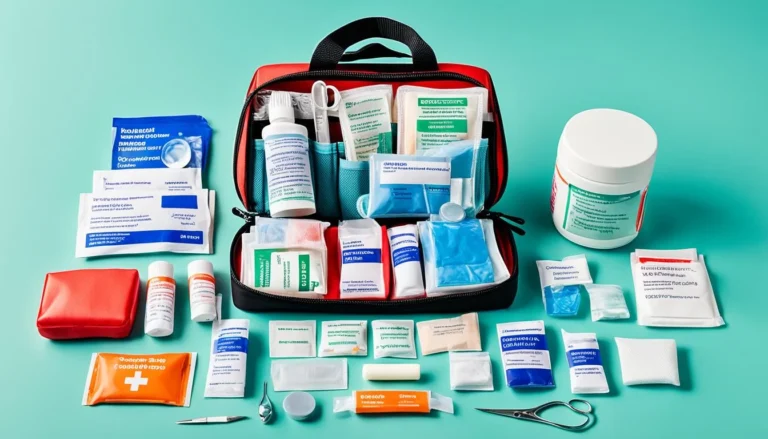Emergency in the Sky: How Well Are Pilots Trained in First Aid?
When we talk about in-flight medical emergencies, we often talk about pilot training. The main goal in aviation is to keep the cockpit secure, especially in emergencies. Because of this, pilot training focuses more on managing the cockpit and keeping it safe than on aviation first aid.
One big rule is that pilots must always be in the cockpit. They do this to make sure it’s never left empty and is always secure. So, when emergencies happen, flight attendants step up. They’re the ones trained in first aid and CPR, ready to help using the first-aid kit on the plane.
This set-up shows how important it is for everyone to work together. Pilots, the cockpit crew, and the cabin crew need to communicate well in emergencies. This way, if needed, they can talk to doctors on the ground for more advice.
Key Takeaways
- In emergencies, pilots focus on cockpit security and management.
- Flight attendants are trained in first aid and CPR to handle medical needs.
- Pilots are required to stay in the cockpit for security reasons.
- Coordination between the cabin crew and pilots is crucial for effective emergency response.
- Long-range communication systems enable contact with ground-based medical professionals.
The Role of Pilots During In-Flight Emergencies
When emergencies strike during flights, pilots focus first on cockpit security and managing the aircraft. They have key duties to keep the flight safe. This includes working closely with the cabin crew and dispatchers for any medical needs.
Keeping the cockpit secure is vitally important when emergency cases arise. It needs a lot of attention from the pilot. They need to be ready for anything. Pilots, though, don’t learn a lot about first aid. This is because their role in emergencies doesn’t include treating the passengers.
Pilots team up with expert cabin crew to handle medical issues during flights. This teamwork is key for quick decisions and actions needed for medical emergencies. Pilots ensure everyone is safe on board. Meanwhile, the cabin crew takes care of the passengers’ immediate needs.
The Extent of First Aid Knowledge Among Pilots
Pilots are key for flight safety and often face medical emergencies. Their first aid skills come mostly from past experience. This is more than from required teachings.
They follow rules set by aviation and their company. These define what pilots and cabin crew do in health crises aboard. It’s about working together for passenger welfare.
Do Pilots Receive First Aid Training?
Most airlines don’t make extensive first aid a must for pilots. They gear towards flight safety and cockpit control. Yet, pilots from a military background might know more about first aid. This is thanks to their service experience.
Regulations for First Aid Training
First aid rules in aviation mainly focus on cabin crew. They need to be ready for any onboard medical issues. This includes knowing CPR and how to use defibrillators.
While pilots are not the first in medical emergencies, they play a key role. They help organise with cabin crew, who have the full medical training.
Understanding Crew Responsibilities During Medical Emergencies
In-flight medical emergencies need fast action. It’s vital that the flight crew knows their roles. This helps passengers get top care and keeps the flight safe. Pilots and cabin crew must work together well to handle these situations smoothly.
Pilot’s Responsibilities
Pilots must keep the flight deck secure and in control during medical issues. They manage flight changes, work with the cabin crew, and focus on flying the plane safely. Staying in the cockpit helps them pay close attention to flying and make any needed changes.
Cabin Crew’s Role
The cabin crew plays a key role in handling in-flight medical problems. They know first aid and CPR and use medical equipment like defibrillators. They have clear steps for telling pilots about serious issues and getting help from doctors on the ground. This ensures sick passengers get help quickly and effectively.
- Assessing the situation and providing immediate flight attendant first aid.
- Using in-flight medical kits and equipment.
- Communicating with pilots and potentially grounding medical professionals.
| Responsibility | Pilots | Cabin Crew |
|---|---|---|
| Primary Focus | Flight Deck Security | In-flight Medical Response |
| Emergency Actions | Flight Diversions | First Aid, CPR |
| Medical Training | Basic awareness | Comprehensive, including device usage |
Do Pilots Know First Aid?
Pilots may have varying experiences with first aid. They often bring knowledge from past jobs, like in the military. In these roles, they learn basic medical skills that help in emergencies.
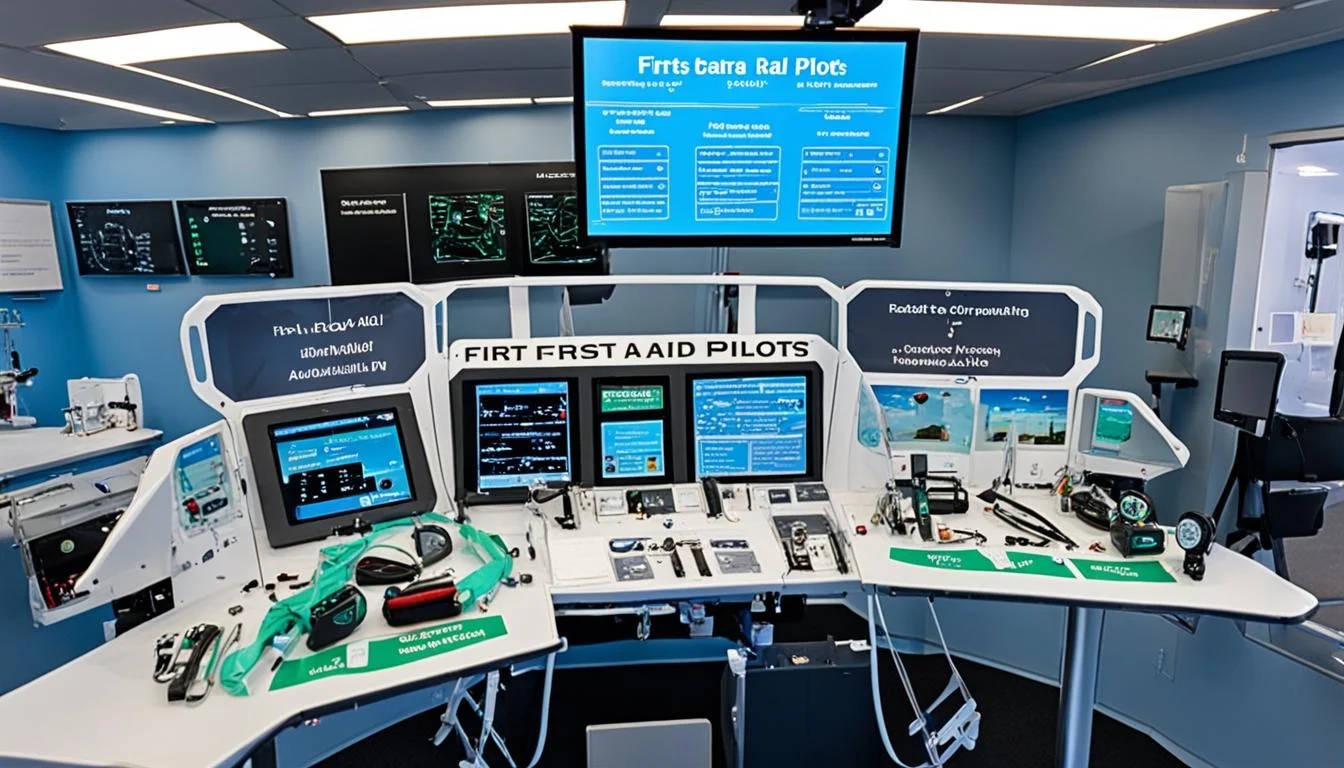
The main task of pilots is to keep the plane safe and fly it well, even in emergencies. This role keeps them fully in charge of the plane, following strict safety rules while flying. This means they are not the main ones giving medical help. During health problems on a flight, the cabin crew usually takes care of passengers needing help.
The aviation world doesn’t always ask pilots to be first aid experts. However, a coordinated effort across the industry means pilots are ready for safety situations. This teamwork helps in using safety and health care effectively, making flying safer for everyone.
The Importance of First Aid Training for Cabin Crew
First aid training is a must for cabin crew. It highlights their key role in dealing with health issues in the air. This training gives flight attendants the skills to handle many health emergencies, keeping passengers safe.
They are ready to face all kinds of health problems, from small to big. Offering quick aid boosts how they react to emergencies on planes. It makes sure they can help until doctors can step in. They also learn how to use special medical kits and tools.
On planes, cabin crew are the first to help in medical situations. Their first aid knowledge lets them manage any sudden health problems, helping everyone on board. This is key to looking after passengers well.
They undergo training in CPR and defibrillator use, crucial for heart attacks. They also learn to spot and treat common health issues on flights. This training makes them a strong line of defence in air travel emergencies.
To sum up, first aid for flight attendants is crucial for passenger safety. It ensures cabin crew can handle any health crises in the air, offering comfort and aid. They are trained to keep situations under control until the plane lands or a doctor arrives.
Typical In-Flight Medical Emergencies
Talking about common in-flight emergencies shows us the many health and injury risks. Some health issues can need quick help from the cabin crew. This quick response can be life-saving.
Common Health-Related Issues
Facing health emergencies during a flight is not uncommon. It ranges from minor problems like fainting to major issues like heart attacks. The cabin crew is there to help in these tough times, giving first aid till landing or more help arrives.
Injury-Related Emergencies
Injuries can happen for various reasons, like from turbulence or accidents on board. The cabin crew knows how to help, keeping passengers safe until they can get more medical aid.
Medical Equipment Available on Commercial Flights
Commercial flights have many medical tools for passengers’ health needs. They make sure any medical crisis is handled well until there’s help on the ground. Flights may carry kits for many medical issues, AEDs for heart problems, and oxygen for breathing troubles.
Ancillary Medical Kits
Ancillary medical kits are advanced first aid kits. They have medicines, tools, and items to assess and treat many health issues. Crew members know how to use these kits to help passengers until they can get more help.
Automated External Defibrillators (AEDs)
Having AEDs on flights is a big deal for medical emergencies. These devices can restart a person’s heart if they go into sudden cardiac arrest. Their presence means lives can be saved in the air, a key part of flying safely today.
Supplemental Oxygen
Providing extra oxygen is key on planes. It helps with breathing problems, whether due to cabin pressure drops or medical issues. This service is vital for keeping everyone well during the journey.
Now, let’s compare the essential medical gear on flights:
| Medical Equipment | Purpose | Crew Training |
|---|---|---|
| Ancillary Medical Kits | Comprehensive medical care | Trained in usage |
| AEDs | Treat cardiac arrest | Certified in AED usage |
| Supplemental Oxygen | Manage respiratory issues | Trained in administration |
Coordination with Ground-Based Medical Support
During an in-flight medical consultation, everyone needs to talk well. This means the cabin crew, the pilot, and doctors on the ground must all work together. They use special systems like AirInc or TELESIS to connect. These let the staff speak to doctors far away for quick advice. This way, passengers get the best care possible in the air.
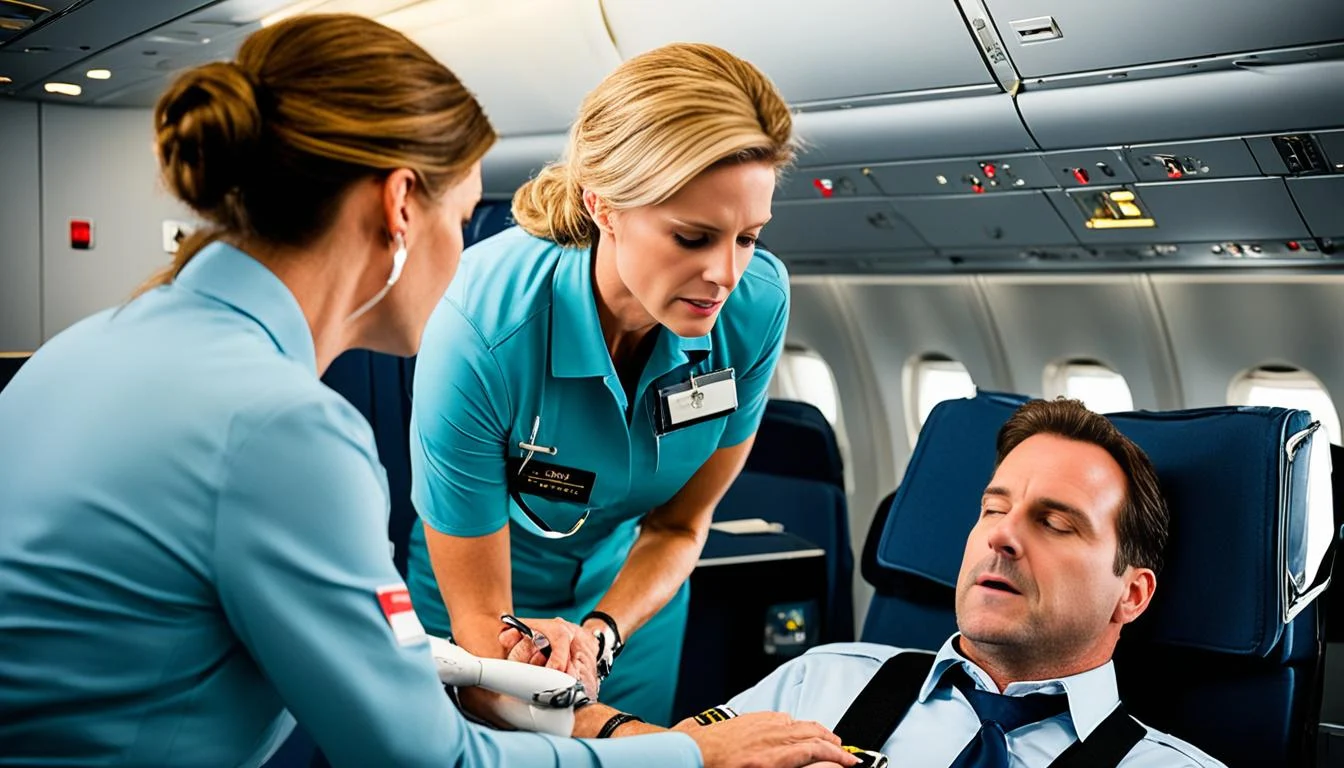
Pilots are key in making sure this happens smoothly. They pass on important info from the cabin crew to doctors on the ground. This helps in making a quick and right diagnosis. Sometimes, this teamwork means the flight might change its course to land at a better medical spot. And this keeps the passenger from waiting too long for help.
Here are the important parts in working together for emergency medical help:
| Element | Description |
|---|---|
| Cabin Crew | Checks the first steps and gets info about the patient |
| Pilot | Helps talk and decides if the flight needs to go somewhere else |
| AirInc/TELESIS | Makes long-distance medical talks possible |
| Ground-Based Medical Professionals | Give immediate medical advice and tips |
Protocols in Place for In-Flight Medical Emergencies
Airlines have strict rules, called aviation medical protocols, for dealing with in-flight medical issues. These steps include a set of emergency response procedures. The aim is to keep passengers safe and well. First, cabin crew will check the situation. They use their training to figure out how serious the issue is. They might also ask any doctors on board for help.
If the problem is serious, the crew can call doctors on the ground for advice. This expert opinion helps them make better decisions. After getting advice, the Captain decides what to do. They might continue to the original airport or land at a closer one for emergency help.
The Captain’s decision looks at the medical need, how it affects the flight and the airport, and if it changes the flight schedule. Important aviation medical protocols and good communication between crew and doctors help. They make sure the action taken is best for the sick passenger and everyone’s safety.
- Initial assessment by trained cabin crew
- Engaging onboard medical professionals, if available
- Remote consultation with ground-based medical services
- Decision-making by the Captain on course of action
- Potential diversion to a nearer, more equipped aerodrome
These steps show how airlines work hard to keep everyone safe. They have clear rules for what to do in emergencies. This includes making changes to the flight path when needed.
Overall Importance of Emergency Preparedness in Aviation
The aviation world takes emergency readiness very seriously. It’s key for keeping flights safe. Both pilots and cabin crew get lots of training. And the planes are fully equipped to look after you. This means everyone is ready to deal with any medical needs during the journey.
When things go wrong, pilots keep the flight deck safe. They help talk to doctors on the ground. The crew knows how to help with many medical issues, on board or later. This team effort ensures everyone’s safety, no matter what.
Planes also carry important medical gear, like AEDs and extra oxygen. This extra support means the whole system is ready to act fast. With experts and special tools ready, both passengers and the crew feel more secure. They know help is at hand if there’s a problem.

